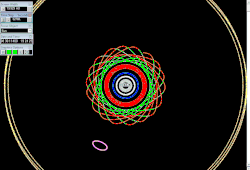5222 Ioffe

Rotating frame animation in reference to Jupiter. Each frame 81 years.
|
|
| Discovery | |
|---|---|
| Discovered by | N. S. Chernykh |
| Discovery site | Crimean Astrophysical Obs. |
| Discovery date | 11 October 1980 |
| Designations | |
| MPC designation | 5222 Ioffe |
|
Named after
|
Abram Ioffe (Soviet physicist) |
|
1980 TL13 · 1978 LP 1989 TG1 |
|
| main-belt · (outer) | |
| Orbital characteristics | |
| Epoch 16 February 2017 (JD 2457800.5) | |
| Uncertainty parameter 0 | |
| Observation arc | 64.08 yr (23,405 days) |
| Aphelion | 3.1728 AU |
| Perihelion | 2.3788 AU |
| 2.7758 AU | |
| Eccentricity | 0.1430 |
| 4.62 yr (1,689 days) | |
| 172.25° | |
| 0° 12m 47.16s / day | |
| Inclination | 34.539° |
| 220.66° | |
| 331.02° | |
| Physical characteristics | |
| 19.4 h | |
|
0.1463±0.012 0.202±0.041 |
|
| B (SMASSII) | |
| 11.4 | |
5222 Ioffe, provisional designation 1980 TL13, is a rare-type carbonaceous asteroid from the outer region of the asteroid belt, approximately 18 kilometers in diameter. It was discovered on 11 October 1980, by Soviet astronomer Nikolai Chernykh at the Crimean Astrophysical Observatory in Nauchnyj, Crimea. It is the largest of the Palladian asteroids apart from Pallas itself.
Ioffe orbits the Sun at a distance of 2.4–3.2 AU once every 4 years and 7 months (1,689 days). Its orbit has an eccentricity of 0.14 and an inclination of 35° with respect to the ecliptic. A first precovery was taken at Palomar Observatory in 1952, extending the asteroid's observation arc by 28 years prior to its official discovery observation at Nauchnyj.
Photometric observations of this asteroid collected during 2006 show a rotation period of 19.4 ± 0.2 hours with a brightness variation of 0.27 ± 0.03 magnitude.
This minor planet was named in memory of Soviet physicist Abram Ioffe (1880–1960), an expert in electromagnetism, radiology, crystals, high-impact physics, thermoelectricity and photoelectricity. Ioffewas a pioneer in the investigation of semiconductors. Proposed by the Institute of Theoretical Astronomy, naming citation was published on 5 March 1996 (M.P.C. 26763).
...
Wikipedia
